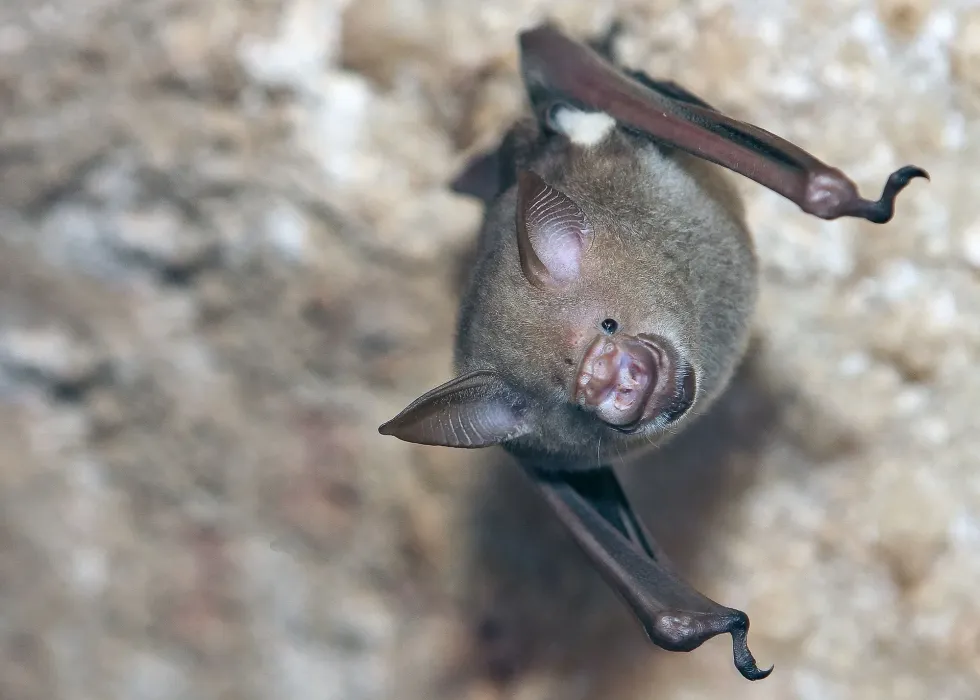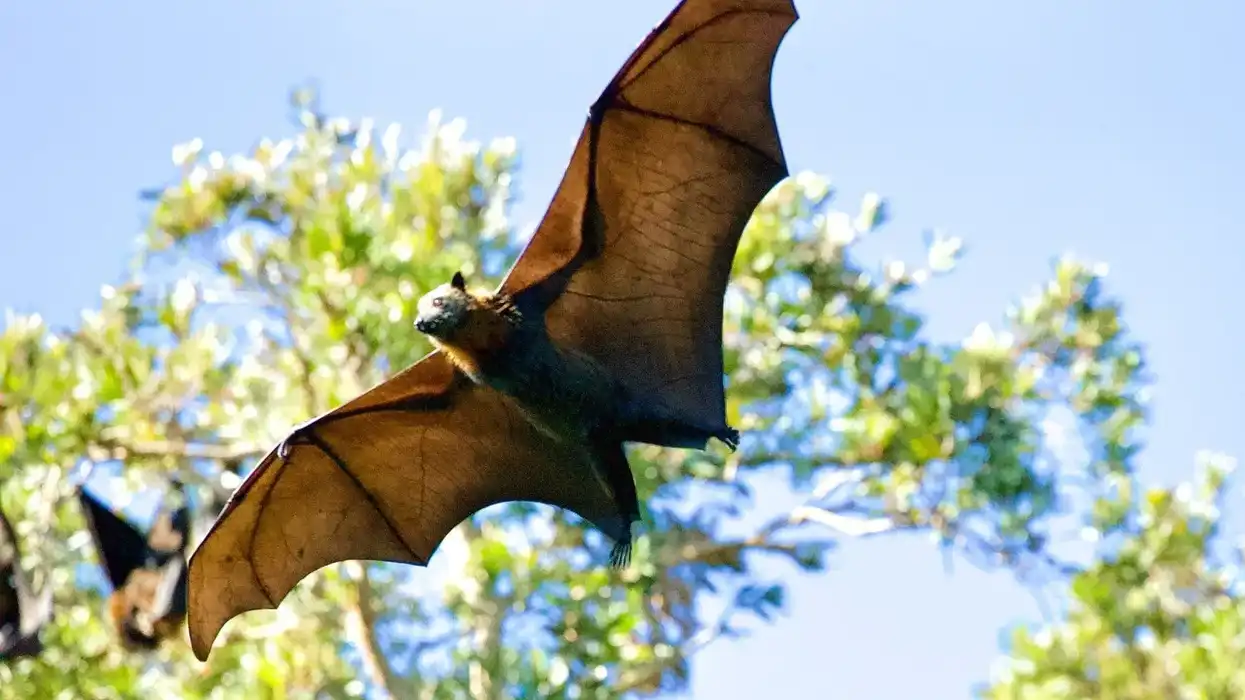The great roundleaf bat (Hipposideros armiger) is an amazing creature with a lot of interesting features. For starters, these leaf-nosed roundleaf bats have very broad wings that are also incredibly strong to help them fly through the night in search of food and other round leaf bats, their main competitor!
When it is time to mate these creatures will do so up high in trees or cliffs.
The great leaf-nosed roundleaf bat (Hipposideros armiger) is the largest bat in north and south Asia, with a massive wingspan. This leaf-nosed roundleaf bat species' name comes from its large round ears that are shaped like leaves.
These bats live primarily near water sources such as rivers or lakes where they can find food and shelter. They mainly eat beetles, but will also consume other insects when necessary for survival.
The mating season lasts until October or November and females give birth soon after winter begins.
Their gestation period averages four months long and usually only one pup results from each pregnancy (although some may have twins). Young pups grow quickly by consuming lots of protein-rich milk produced by nursing mothers.
Primarily nocturnal, these bats like dark caves or understory vegetation to roost in during the day. They can also be seen hunting outside at dusk throughout their population distribution range when it’s not too bright so predators won’t see them!
The Hipposideros armiger species has long, brown, or dark gray fur and big eyes that glow in the darkness when they fly during full moons and other nocturnal events.
They use echolocation to navigate through their environment by producing sound waves at high frequencies which bounce off objects near them such as obstacles in the way or even prey. This helps them to navigate without sight!
For more relatable content, check out these hoary bat facts and red bat facts for kids.
Great Roundleaf Bat Interesting Facts
What type of animal is a great roundleaf bat?
Great leaf-nosed bats are a type of bat that is often found roosting during the day throughout its population distribution range.
What class of animal does a great roundleaf bat belong to?
The great leaf-nosed roundleaf bat population belongs to the class Mammalia, phylum Chordata, and genus Hipposideridae.
How many great roundleaf bats are there in the world?
The best estimates say that there may be less than 30,000 individuals in this bat population left.
Where does a great roundleaf bat live?
They are found in a range of caves or trees near water sources. These habitats provide enough food so they can survive during dry seasons when many insects aren't around to feed on. A great leaf-nosed roundleaf bat's favorite habitat is tropical forests.
What is a great roundleaf bat's habitat?
Great leaf-nosed roundleaf bats of the genus Hipposideridae and order Chiroptera can be seen living inside forests or deep within dark caverns in Asia, particularly in China! They inhabit countries across Asia including Thailand and Indonesia but are best known throughout their range of China and southern Europe such as Italy and Spain.
They roost on cave ceilings during daylight hours before flying out at nightfall to hunt insects by echolocation just like many other members of this fascinating family!
Who do great roundleaf bats live with?
These leaf-nosed bats of the order Chiroptera usually reside with other great roundleaf bats and make their homes out of trees, leaves, or vines mostly around Asia, including in China.
How long does a great roundleaf bat live?
Bats in the leaf-nosed bat species of the class Mammalia typically live to be three years old but they can live up to 10 years with some variation depending on their location.
How do they reproduce?
This great leaf-nosed species mates in the spring. Males find a roost to court females from while they are looking for food, and then when it is time for the mating season they show off their best dance moves to attract female bats!
What is their conservation status?
In the IUCN list of threatened species, these leaf-nosed bats fall in the Least Concern category!
Great Roundleaf Bat Fun Facts
What do great roundleaf bats look like?
The roundleaf bat is a type of leaf-nosed bat with an extremely broad nose that leads to its common name. They can be identified by their large ears, their dark brown or black hair, and their grayish wings.
Their wings have white spots near each wing's inside edge on each side. This leaf-nosed bat species belongs to the kingdom Animalia, family Hipposideridae, genus Hipposideros, class Mammalia, and phylum Chordata!

* Please note that the main image is of a fulvus roundleaf bat, not a great roundleaf bat. If you have an image of a great roundleaf bat please let us know at hello@kidadl.com.
How cute are they?
The great roundleaf species has been described in many differing ways. Some say it's adorable while others see its appearance more akin to something out of a horror movie!
How do they communicate?
This mammal species uses a series of high-pitched squeaks to communicate with one another and to find each other in the dark. This bat roosts during the daytime so it is not very active at this time. They also communicate via echolocation.
How big is a great roundleaf bat?
The great roundleaf species of bats, measuring only 3-4 in (8-10 cm) in length, are most widely found in Asia, especially China.
How fast can a great roundleaf bat fly?
This species of great roundleaf bats can fly between 15-20 mph (24-32 kph).
How much does a great roundleaf bat weigh?
The great roundleaf species is a small mammal that weighs 0.1 lb (60 g) and roosts during the day.
What are their male and female names of the species?
Male and female bats of this species both go by the name Hipposideros armiger or simply leaf-nosed bats.
What would you call a baby great roundleaf bat?
A baby of the great roundleaf bat species is known as a pup!
What do they eat?
Their diet is very varied throughout their distribution range. This animal species' diet includes a wide variety of insects, flies, giant water bugs, and worms.
Are they dangerous?
The great roundleaf species can be dangerous if you're not careful. However, mostly, they do not bother humans whatsoever!
Would they make a good pet?
The great round leaf bat lives in diverse habitats all over the world, including deserts and rainforests as well as temperate zones. However, it will not be suitable for your house!
Did you know...
Bats are amazing creatures. These bats sleep upside down and use their wings as blankets to stay warm during the cold, winter nights. For better insulation, they tuck themselves in with leaves from trees near where they live, which may be why we call them roundleaf bats!
The great roundleaf bat roosts during the day with its wings wrapped around its body to avoid detection by predators.
How many babies do great roundleaf bats have?
The great roundleaf bat is a species of bat that is known to have just one or two offspring at a time.
Different types of roundleaf bat
There are four closely related subspecies of this insectivorous bat species: Hipposideros bicolor atrox, Hipposideros bicolor major, Hipposideros bicolor bicolor, and Hipposideros bicolor erigens.
Here at Kidadl, we have carefully created lots of interesting family-friendly animal facts for everyone to discover! Learn more about some other mammals from our swamp rabbit facts and Artic hare facts pages.
You can even occupy yourself at home by coloring in one of our free printable great roundleaf bat coloring pages.
* Please note that the main image is of Commerson's roundleaf bat, not a great roundleaf bat. If you have an image of a great roundleaf bat please let us know at hello@kidadl.com.









